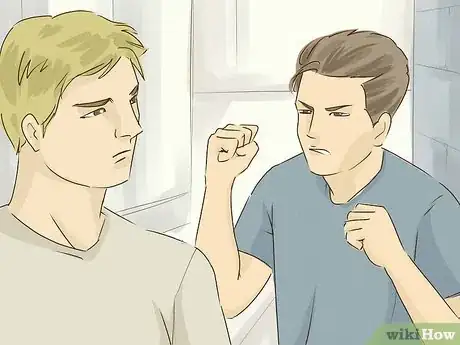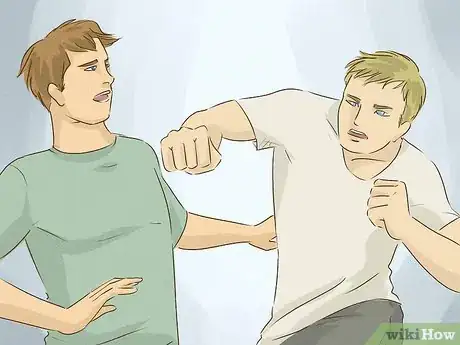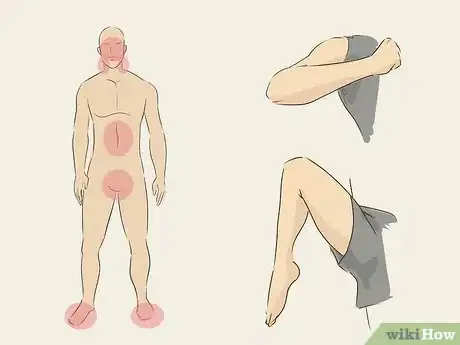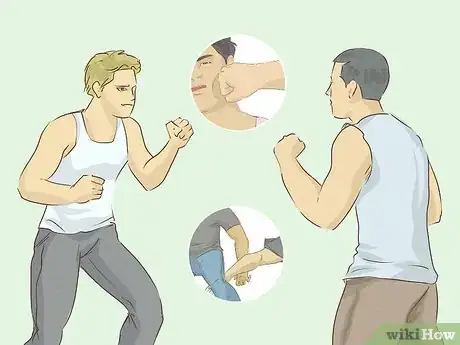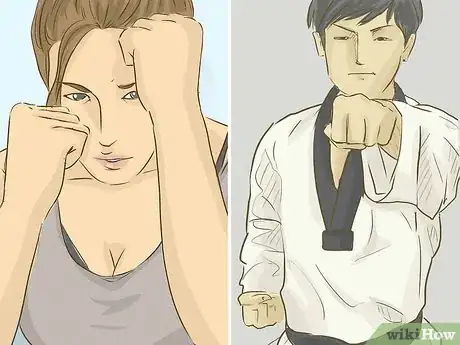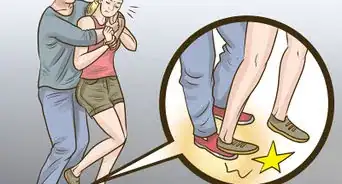This article was co-authored by Dany Zelig. Dany Zelig is the Founder and Owner of Tactica and the Tactica Krav Maga Institute headquartered in San Francisco, California. He is a 2nd generation Israeli Krav Maga instructor of Imi Lichtenfeld, certified directly by Imi’s most senior disciple and Head of the Rank Committee. He received his Military Krav Maga Instructor certification from the Wingate Institute in Israel in 1987.
There are 11 references cited in this article, which can be found at the bottom of the page.
wikiHow marks an article as reader-approved once it receives enough positive feedback. In this case, 83% of readers who voted found the article helpful, earning it our reader-approved status.
This article has been viewed 430,702 times.
One definition of winning a fight is to emerge from the fight uninjured, regardless of what happens to your opponent. The easiest way to avoid injury is to avoid a fight altogether. However, if you are being attacked and you are cornered, the next best thing you can do would be to end the fight as quickly as possible. Some fighting techniques can disable an attacker very quickly. Keep in mind that these techniques are not foolproof, especially if you don't have practice or training.
Steps
Assessing the Threat
-
1Take a few seconds to evaluate the situation. This can make all the difference in winning. Thinking rationally, even for a few seconds, will help you to remain calm so that you can fight with your mind as well as your body.
- Determine whether your opponent seems to be angry (at you or just in general), looking for a fight, mentally ill, or drunk. This information can help you decide the best way to quickly end the fight.
- Before you decide how to fight (or flee), evaluate your opponent's size and strength. Keep in mind the old adage that "The good big man beats the good little man." [1] This doesn't mean that you can't win a fight against an opponent who is larger and stronger than you, but it does mean that you should take these factors into account.
-
2De-escalate anger. If your opponent is yelling, threatening you, or throwing things, but has not yet attacked you physically, you may be able to de-escalate the situation and avoid a fight altogether.
- You must remain calm yourself. Responding to anger with anger will only make the situation worse.
- Tell your opponent you want to hear what he has to say. Listen carefully. If your opponent is in pain or upset, listening quietly may calm them down.
Advertisement -
3Be wary of unpredictable opponents. If your opponent is acting irrationally and unpredictably - such as someone who is drunk or mentally ill - it will be more difficult to de-escalate, but it can be done.
- An opponent who is impaired might not really want to fight you once he's calmed down. This may influence your decision about whether to fight or to try to de-escalate the situation.
- To try to help someone who is impaired to calm down, listen to the person, agree with whatever he says, and then tell him what you want him to do (e.g. sit down, leave). The key is to repeat the loop as many times as it takes - even a dozen times. This technique fails if you give up too soon. [2]
Exploiting Your Opponent's Weaknesses
-
1Avoid your opponent's first attack. If he is rushing at you or throwing a punch, move to the side, then push him down from behind when he has passed you. If the opponent is not a lot bigger than you, you can try sticking your leg in front of him and then pushing him to trip him. This technique uses the opponent's momentum against him.
- You must remain calm and move quickly to get out of the way. Your instincts to avoid a punch or kick should help, but be aware that you may also 'freeze'.
- When you push your opponent, try to thrust away from the ground with your legs and follow through with your arms to deliver the most force possible.
-
2Don't fight the way your opponent wants to. Most people will tend to use one style of fighting - punching, grappling, kicking, etc. Don't engage with the same technique.
- If your opponent punches, try to drag him to the ground.
- If your opponent seems to want to tackle you, try to stay on your feet.
-
3Fight dirty. Fighting techniques such as Krav Maga encourage explosive attacks against the opponent's weakest points. Hit soft, weak parts of your opponent's body (toes, groin, stomach, face, side of the neck) with hard, strong parts of your body (your heel, knee, elbow, heel of your hand, top of your head).[3]
- Stomp on your opponent's toes.
- Kick or punch his groin, the top of his stomach (solar plexus), or the belly button area (diaphragm).
- Gouge your opponent's eyes, or punch him in the nose, chin, or jaw as hard as you can.
- If you are being attacked and have access to anything that can be used as a weapon, use it. You can throw things, such as keys or sand, gravel, or dirt, as well as using things as weapons.[4] You have a right to defend yourself in any way you can. Just keep in mind this doesn't extend to attacking.
-
4Trick your opponent. If you are good at bluffing or acting, you may be able to trick your opponent into making the fight easier for you.
- Adopt a martial-arts style stance and put your fists up in front of your face to encourage your opponent to do the same. If your opponent is not a trained fighter, he may mimic your stance, which puts you in control of the fight.
- Bluff a kick from the side. Make it look like you're going to kick your opponent in the shin. Instead, deliver a strong punch to his face, solar plexus, or diaphragm. Avoid the temptation to look down at your leg, which may telegraph your plan to your opponent.
- If your opponent does not mimic you, this may tell you that he has some training or practice as a fighter.
Borrowing from the Professionals
-
1Use the techniques of the ultimate fighters. In the history of the Ultimate Fighting Championship, 8 fights have ended in 10 seconds or less.[5] You probably don't have the training that these fighters did, but that doesn't mean you can't try to copy or borrow their techniques.
- Professional mixed martial arts fighters train in multiple fighting techniques, including boxing, wrestling, and several types of martial arts.
- Professional fighters train full-time for years to be able to fight effectively.
-
2Begin with a sudden, strong punch. This approach, popular among UFC fighters, can stun your opponent and knock him down. Knowing the proper way to punch can make the difference between you hurting your opponent and you hurting your hand.
- Make sure your thumb is on the outside of your fist.
- Punch with your knuckles - particularly those of your index and ring fingers - and keep your wrist straight. This will deliver a more effective punch and will also make it less likely that you will break any bones in your hand.[6]
- While UFC fighters like Gray Maynard, James Irvin, and Todd Duffee took out their opponents by throwing punches to the head[7] [8] [9] , less trained fighters may have better luck landing a strong punch by aiming for the throat, sides of the neck, or ribs.[10]
- Even though some fighters such as Ryan Jimmo have knocked opponents out with one blow[11] , keep in mind that single-punch knockouts are extremely rare, even in professional boxing and mixed martial arts (MMA).
-
3Start with a kick. British kickboxer Mark Weir beat his opponent, Eugene Jackson, by kicking him and then following up with a perfectly timed punch to the mouth. Jackson fell, ending the fight in 10 seconds.[12]
- Don't copy Jackie Chan. A low, strong kick to the knee or shin is much faster and more effective than a high kick to the head.
- Aim the side of your foot toward the side of your opponent's knee - this will help you maintain your balance while doing maximum damage.[13]
- One advantage to kicking is that it keeps you farther away from your opponent, thereby making it harder for him to hit you.[14]
Expert Q&A
-
QuestionI just don't want to get hurt, what should I do?
 Dany ZeligDany Zelig is the Founder and Owner of Tactica and the Tactica Krav Maga Institute headquartered in San Francisco, California. He is a 2nd generation Israeli Krav Maga instructor of Imi Lichtenfeld, certified directly by Imi’s most senior disciple and Head of the Rank Committee. He received his Military Krav Maga Instructor certification from the Wingate Institute in Israel in 1987.
Dany ZeligDany Zelig is the Founder and Owner of Tactica and the Tactica Krav Maga Institute headquartered in San Francisco, California. He is a 2nd generation Israeli Krav Maga instructor of Imi Lichtenfeld, certified directly by Imi’s most senior disciple and Head of the Rank Committee. He received his Military Krav Maga Instructor certification from the Wingate Institute in Israel in 1987.
Self Defense Trainer You should always try to de-escalate the situation as best you can. The chance of not getting hurt in a fight is very low.
You should always try to de-escalate the situation as best you can. The chance of not getting hurt in a fight is very low. -
QuestionWhat can I do to get an edge in a fight?
 Adrian TandezAdrian Tandez is the founder and head instructor of the Tandez Academy, a world-renowned self-defense training center in Mountain View, California. Trained under the renowned martial artist Dan Inosanto, Adrian is a certified instructor in Bruce Lee's Jeet Kune Do, Filipino Martial Arts, and Silat, among other things. Adrian has over 27 years of self defense training experience.
Adrian TandezAdrian Tandez is the founder and head instructor of the Tandez Academy, a world-renowned self-defense training center in Mountain View, California. Trained under the renowned martial artist Dan Inosanto, Adrian is a certified instructor in Bruce Lee's Jeet Kune Do, Filipino Martial Arts, and Silat, among other things. Adrian has over 27 years of self defense training experience.
Self Defense Trainer If you can't escape the fight, look for something in your environment that you can turn into a weapon (I call this an equalizer). It could be a frying pan, it could be a shoe, it could be a jacket, it could be anything you can use to protect yourself.
If you can't escape the fight, look for something in your environment that you can turn into a weapon (I call this an equalizer). It could be a frying pan, it could be a shoe, it could be a jacket, it could be anything you can use to protect yourself.
Warnings
- If you are attacked by a violent predator whose primary goal is to hurt or kill you, you will have to take control of the situation by choosing the location and moment for an explosive action - either fleeing or fighting. Predators tend to be calm compared to thieves and angry or psychotic opponents. A predatory attacker may try to “herd” you to a private location. Once you know this, the element of surprise passes from your opponent to you and becomes your greatest advantage. Whether you choose to flee or fight, creating or taking advantage of a distraction first can give you another edge over your opponent.⧼thumbs_response⧽
- If you are attacked or threatened by a thief, the fastest way to get out of the situation is to give him what he wants. A thief does not want to hurt you; he just wants items of value. While you do have the right to resist, you may make the situation worse than it needs to be by escalating a property theft into a violent confrontation. If the thief does not threaten you with a weapon, you can try throwing the thing he wants in one direction and running in the other direction. This is an effective distraction, and a thief will probably go after the thing he wants instead of going after you. However, if you are being threatened with a knife or gun, keep telling the thief that you will give him what he wants, and follow his directions to avoid a fight. Once he has what he wants, he will most likely flee.⧼thumbs_response⧽
- Never do something illegal, because it's legal for someone to physically injure you right away to stop you from:
- Committing a violent crime (e.g. in self-defense)
- Leaving after you clearly did something illegal (e.g. by a citizen's arrest), especially when it's a felony, and
- Resisting arrest if that person is a police officer who is arresting you, which is illegal, even if you're innocent.
⧼thumbs_response⧽ - Committing a violent crime (e.g. in self-defense)
References
- ↑ http://a.espncdn.com/boxing/columns/kellerman_max/1463715.html
- ↑ http://www.ncbi.nlm.nih.gov/pmc/articles/PMC3298202/
- ↑ https://www.artofmanliness.com/articles/a-primer-on-krav-maga-the-combative-system-of-the-israeli-defense-forces/
- ↑ http://lifehacker.com/5825528/basic-self-defense-moves-anyone-can-do-and-everyone-should-know
- ↑ http://bleacherreport.com/articles/2074623-every-ufc-knockout-that-happened-in-10-seconds-or-less
- ↑ http://lifehacker.com/5829523/how-to-throw-a-punch-correctly
- ↑ http://bleacherreport.com/articles/2074623-every-ufc-knockout-that-happened-in-10-seconds-or-less/page/5
- ↑ http://bleacherreport.com/articles/2074623-every-ufc-knockout-that-happened-in-10-seconds-or-less/page/6
- ↑ http://bleacherreport.com/articles/2074623-every-ufc-knockout-that-happened-in-10-seconds-or-less/page/7
- ↑ http://lifehacker.com/5829523/how-to-throw-a-punch-correctly
- ↑ http://bleacherreport.com/articles/2074623-every-ufc-knockout-that-happened-in-10-seconds-or-less/page/9
- ↑ http://bleacherreport.com/articles/2074623-every-ufc-knockout-that-happened-in-10-seconds-or-less/page/3
- ↑ http://lifehacker.com/5825528/basic-self-defense-moves-anyone-can-do-and-everyone-should-know
- ↑ http://lifehacker.com/5825528/basic-self-defense-moves-anyone-can-do-and-everyone-should-know
About This Article
To win a fight in under 30 seconds, try to avoid your opponent’s first kick or punch by stepping to the side, then use their momentum to push them down from behind. Give them the strongest push possible by thrusting off the ground with your legs and following through with your arms. You could also try striking weak parts of your opponent’s body, such as their stomach, groin, or the side of their neck, with kicks or punches. If you have some training as a fighter, try bluffing to catch your opponent off guard. For example, pretend to launch a kick at your opponent’s shin, then strike them with a hard punch on the jaw or in the ribs while they’re distracted. If you’d rather kick your opponent, aim the side of your foot at their knee, which will cause the most damage while allowing you to stay balanced. For tips on how to de-escalate a situation before a fight breaks out, keep reading!
